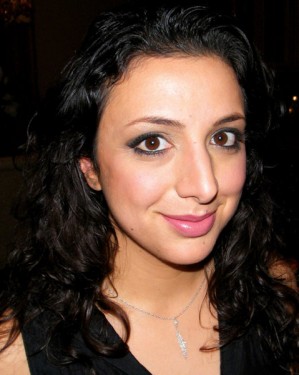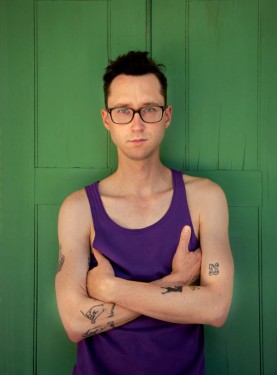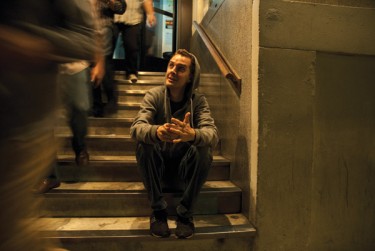 Back to selection
Back to selection
25 NEW FACES – PART 5
Susan Youssef

- SUSAN YOUSSEF.
At the IFP Narrative Lab, a mentor said of Susan Youssef’s first feature, Habibi Rasak Kharban (literally, “Darling, Something’s Wrong with Your Head”): “It’s a classic story, like Romeo and Juliet.” True, but the roots of Youssef’s story go back far further. The film is an adaptation of the 12th-century Sufi parable Majnun Layla, which was itself based on a 7th-century Arabic story. Over the years, the tragic tale of undying love between a woman and the wandering poet her family forbids her to marry has formed the basis for countless works of art, from Shakespeare’s classic to several Indian films of the 1920s to even pop songs like Eric Clapton’s “Layla.”
Youssef is currently in post on her feature, and it’s been a long road. “I’ve been working on the film for eight years, continuously,” she says. “I’ve never fought for something so hard before — I’ve defined my whole existence around this film.” The feature began in 2002 when Youssef traveled to Gaza while in post on a short documentary, Forbidden to Wander. She noticed all the graffiti on the walls there, and decided to make Majnun Layla’s poet one who scrawled his works on walls for all to see. She received a Fulbright scholarship to work on the script and, later, brought on an Islamic specialist as a co-writer. In 2007 she traveled to Gaza with the intention of shooting the film there, but the violence was too heavy. Realizing she needed a backup plan, she visited the West Bank and figured out ways she could cheat it for her Gaza locations. She also cast Palestinians with Israeli passports so that she’d be able to shoot in the West Bank if she had to. “In 2009 I finally raised enough money to make the film, and I had an organization sponsoring my application [to shoot] in Gaza, but it was denied. We went ahead and finally shot in the West Bank, although the film is still the first film set in Gaza in 15 years.”
Youssef was born in Bay Ridge, Brooklyn to a Lebanese father and Syrian mother. She attended University of Virginia undergrad, worked as a journalist in Beirut after college, and returned to the States to go to UT Austin Film School — “without my parents consent,” she adds. “It was a huge problem. They had somebody they wanted me to marry. It was a big culture clash. I chose film over family.” Habibi Rasak Kharban was funded through a who’s who of non-profit film funders, including Cinereach, the Jerome Foundation and the Princess Grace Foundation.
The Amsterdam-based Youssef, whose earlier shorts played the gay and lesbian festival circuit as well as video-art venues, cites a number of influences on her feature, which was shot by 2006 25 New Face P.J. Raval: the novels of Haruki Murakami, Wagner’s Ring Cycle, and the films of Abbas Kiarostami and Rainer Werner Fassbinder. She also cites Austin’s Richard Linklater as a key inspiration. From him she learned the benefits of basing a film around a community. “When I worked in Ramallah, I made a decision to work as locally as possible,” she says. “Most of my crew were Palestinian and had never been the head of their departments before.” Linklater’s moral support also proved essential. “In 2007, when I came back from Palestine with no film due to the in-fighting in Gaza, I had given up and let him know. He wrote me a brief e-mail that motivated the hell out of me. This project has taken me eight years to make but without influences like him, I could not have made it.” — Scott Macaulay
Contact: habibithefilm.com
Danfung Dennis
Danfung Dennis, who is self-lensing his first directorial effort, says he had never handled a video camera before starting production. But for Dennis, who made his name as a photojournalist covering strife in China, Iraq and Afghanistan, the transition was an organic one. “The Canon 5D Mark 2 came out,” he remembers, “and it was very similar to the cameras I had been using. With just one button push I was shooting HD video.”

- DANFUNG DENNIS. PHOTO BY RICHARD KOEK
Dennis, who had been shooting in Kabul for Newsweek, thought he might make a short Web video about the conflict there. But soon Dennis upsized his ambitions, deciding to make a feature while embedded with the Echo Company, 2-8 Second Marines in Afghanistan. “I wanted to apply the aesthetics but also the ethics of photojournalism to documentary filmmaking,” he says. “As a photojournalist, I have always tried never to interfere, to always be an observer. To try to be honest, truthful and to convey emotion. I’ve been inspired by James Nachtwey, the godfather of photo journalism — his work in conflict areas and the idea that powerful images can shake people from their indifference.”
Enamored of the Canon camera but realizing its shortcomings in the field, Dennis used a skateboard wheel as a follow focus and built a custom audio system and Steadicam device so he “could be running along with the marines while shooting.” His unit soon participated in a large helicopter assault ordered by the Obama Administration to break a stalemate with the insurgents. “Shortly after we were dropped we were surrounded and attacked, and the only cover was this area of rubble known as Machine Gun Hill. Sgt. Nathan Harris, 25 years old, from North Carolina — he was an incredible leader, and I followed him as he led his men to battle. One marine died, and nine more collapsed from exhaustion. Six months later he himself was shot during an ambush and was close to bleeding to death. He was medevaced back to the U.S. and that’s when I rejoined him, following him as he went through a transition to civilian society.”
Dennis continutes: “I don’t think there are films that follow one character from the frontlines back home in such an intimate and visceral way.” Indeed, what is potentially strongest about Dennis’s feature, To Hell and Back, currently in post, is the cinematic feel of his footage — the fusion of his trained photographer’s eye with the filmic qualities of the Canon 5D. And while the smooth, up-close battlefield material is eerie and suspenseful, it’s the elegantly photographed personal drama that unfolds in Harris’s hometown of Yadkinville, N.C., as he tries to both reconnect with his wife but also overcome his injuries so he can rejoin his men in the field, that could make the movie a unique war doc.
To Hell and Back is being edited in Portland by Iraq in Fragments editor Fiona Otway. Usually based in London, Dennis hopes to have a rough cut in the fall. And then there’s Condition One, a new company Dennis is fund-raising for that “will use a network of journalists, filmmakers and servicemen to send a stream of high-quality video to millions of mobile devices.” — S.M.
Contact: danfungdennis.com; danfung at gmail dot com
Arielle Javitch
For Arielle Javitch, whose first feature, Look, Stranger, is currently in post, moviemaking and movement have always been intertwined activities. She began her career as a dancer, and when a back injury sidelined her from performance, she began to make short dance films. “They started as pure movement, and then they began to get more narrative,” Javitch remembers. “One of my shorts was about refugees, and I used testimonies from different [refugee] stories, trying to make them visual through dance and other imagery. The film was beautiful, but it didn’t succeed, and then I knew I had to move into narrative filmmaking for [this refugee story] to have an impact.”

- ARIELLE JAVITCH. PHOTO BY RICHARD KOEK
Javitch began to develop a screenplay based on a simple but dramatically fraught tale of movement — the story of a refugee woman maneuvering herself home through a war zone. To understand the psychology of her protagonist, Javitch researched various refugee crises and did interviews, but she also simply imagined herself as the woman. “I tried to make it very personal,” she says. “Would I fight, or would I yield in these kinds of situations?”
In 2007 Javitch decided to make a short from a few of her screenplay’s scenes. “It was a disaster,” she laughs. “I cast non-professionals and had them speaking Chechen and worked rigorously from my script. I didn’t allow the actors any freedom.” Nonetheless, the short impressed the Berlin Talent Campus, which invited Javitch to attend with her project. “People really responded to it. Everybody thought it was about them. Palestinians thought it was about them, Albanians thought it was about them. The script was specific, but it was also spare, and with universal elements.”
Around this time Javitch began working with producer Lisa Muskat, whom she met through her sister, a costume designer. Over the next two years, the project came together almost “through trial and error,” she says, as Javitch and Muskat looked for a shooting location, agreeable production partners, and an actress to play the journeying refugee. They wound up in Serbia with 4 Months, 3 Weeks and 2 Days star Anamaria Marinca in the lead role. “Anamaria is one of the smartest people I’ve ever met,” Javitch says, “which is intimidating. But she really helped me elevate the thought level of the project. There was a question of, “Would this film succeed as a parable without being grounded in the reality of a specific war?” She was behind me [in avoiding the specific]. I tried to find a balance between realism and allegory. The tension between the real and the allegorical, that’s what’s most interesting to me, and Anamaria helped me be fearless in my choices.”
Look, Stranger, which was made through private equity and grants from organizations like Cinereach and the Sundance Institute/Annenberg Foundation, is currently in post, having completed a cut at the Edit Center in New York City. And now that she’s about to start submitting it to festivals, Javitch, who works as a yoga instructor when she’s not making films, is suddenly a bit more reticent to actually describe her movie. “It’s an antiwar film, but also, without wanting to sound too grand, I want it to be a search for meaning. I want it to ask the question of why are we here. But, in a way, it was much easier to describe with words before it was made. Now that it’s made it’s hard to speak for it.” — S.M.
Contact: lookstrangerfilm at gmail dot com
Matt Porterfield
For decades John Waters has been the filmmaker who has sprung to mind when one thinks about Baltimore and the movies. But with the release of his exquisitely directed, formally rigorous second feature, Putty Hill, Matt Porterfield adds his name to the city’s cinematic honor roll. “For me, Baltimore — the physical environment and its people — is a real source of inspiration,” he says. “It’s a diverse but stratified city, an amalgam of the North and South, divided along race, class, and socioeconomic lines. I hope my films can perform some kind of social function by bridging gaps and offering a shared vision of city life that is underrepresented in the mainstream media.”

- MATT PORTERFIELD. PHOTO BY RICHARD KOEK
In Putty Hill, a circle of friends — some adults but mostly youth — gather to attend the funeral of a young man who has died of a drug overdose. Some return from out of town. Others are Baltimore lifers who journey just a few blocks. Porterfield’s camera (beautifully d.p.ed by Jeremy Saulnier) cuts from neighborhood to neighborhood, clique to clique, and in doing so alternates between fiction and documentary styles. Some scenes unfold in dramatic fashion; other times, the action stops, and Porterfield’s off-camera voice engages in a Q&A with the actors, as if they are being tailed by a documentary film crew. One person begins to stand out: Jenny, a taciturn teenager played by singer-songwriter Sky Ferreira. She’s come back to Baltimore for her cousin’s funeral, a trip that seems to be causing her stress and anxiety. In an astonishing scene late in the film, Ferreira comes across her estranged father, played by non-actor and tattoo artist Charles Sauers, and we sense why.
The story of how Putty Hill came to be has been told on the film’s website (puttyhillmovie.com) and during the course of the successful Kickstarter campaign that raised more than $20,000 for its postproduction and travel to Berlin, where it world-premiered at the Berlin Film Festival. As this story goes, Putty Hill was a “Plan B” picture improvised around a five-page treatment. Briefly, Porterfield recounts: “We were hoping to shoot a larger-scaled feature script called Metal Gods, which was also focused on the daily lives of these characters. It was 120 pages, had a three-act structure, and we hoped to shoot it in July of ’09. When [financing fell through], we had our cast, a number of our locations, 20 grand and a camera package from the IFP from being in the Emerging Narrative Lab. So we just moved forward. There was a lot of magic.”
Recently Putty Hill was picked up for distribution by Cinema Guild, which will put it in theaters this fall. The company also acquired Porterfield’s barely-seen first feature, Hamilton, for DVD. Plus, Porterfield has been exploring an intriguing new direction. “I recut Hamilton down to 45 minutes, and it’s been playing on a loop as part of a show at the Baltimore Museum of Art. I took out a lot of the dialogue and the exposition. It’s a really different approach to time and narrative where the image predominates.” Going forward, Porterfield says he’ll develop another larger script and continue to create work for museums and galleries, but also keep making small films like Putty Hill in Baltimore. “I just want to keep working,” he says, “and I’ll take a ‘by any means necessary’ approach.” — S.M.
Contact: puttyhillmovie.com; matthew dot porterfield at gmail dot com
Adam Bowers
“I know a lot of filmmakers grew up making movies, but I didn’t really do that,” reveals Adam Bowers, the writer, director and star of the Sundance NEXT entry New Low. “While they were getting experience I was just getting experience being an idiot.”

- ADAM BOWERS. PHOTO BY AMANDA BARNES
If you caught his film in Park City this year then you’re probably not surprised by this admission. Perfectly playing the quintessential neurotic schlub, Bowers, 25, has always been fascinated by characters who are a bit self-serving and not too bright. But what makes New Low stand out from other indie comedies is its keen sense of the deadpan setup and the follow-through punch line, which Bowers grasped through hours of watching Woody Allen and Larry David. (He admits to being a huge Seinfeld fan as a kid.) With his sheepish expressions, he plays the film’s lead, Wendell, as a pathetic twentysomething wandering the streets of Gainesville, Fla., with no sense of purpose other than making sure his zipper is up. But inconceivably Wendell finds himself caught in a love triangle with a sweet and caring social worker, Joanna (Valerie Jones), and Vicky, an angry drunk bartender (Jayme Ratzer).
Bowers made the film last year after graduating from the University of Florida. Feeling he had to have made something before moving out to L.A., he expanded a short he shot in school, calling on his friends to be his cast and crew. “We shot over the course of five weeks,” he says. “Some days would be two hours, others would be 20. We just had to take what we could get.”
Having acted with the local improv groups in Gainesville, he wasn’t too intimidated by being in front of the camera for the entire film but he says when it came to the script he was very particular. “I’m kind of OCD with my scripts,” he says. “When I was writing [New Low] I was literally going over and over it, adding commas and things like that, things that didn’t even matter. We had some improvised scenes, but mostly I wanted it to be tightly scripted.”
Though New Low wasn’t the most talked-about title in Sundance’s NEXT section, it got Bowers representation in L.A. and he’s confident that a DVD/VOD deal for the film is imminent. Up next could be a few acting gigs, but Bowers says he’s more focused on his own writing-directing projects. “I like that I have my own work and my own little world to go back to,” he says. “Hopefully my next thing can be on a larger scale than New Low, but if not I know now how to do it the bare-bones way.” — Jason Guerrasio
Contact: Brad Petrigala at Brillstein Entertainment Partners: (310) 205-5145; Christopher Smith and Ida Ziniti at Paradigm: (310) 288-8000





